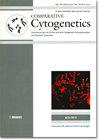党参复合体(禾本科)rDNA基因座的分布模式
IF 0.9
4区 生物学
Q4 GENETICS & HEREDITY
引用次数: 1
摘要
摘要Loliinae(Poacee)亚族的单子叶植物Lolium复合体包括几种具有重要经济价值的牧草和草坪草。该复合体包括林奈Lolium Linnaeus,1753,林奈Festuca Linnaeu斯,1753 Schedonorus亚属(P.Beauvois,1824)Petermann,1849和Micropyropsis Romero Zarco et Cabezudo,1983。对三个物种的5S和18S–26S rDNA序列的新FISH结果进行了介绍,并在对复合物中5S和18S-26S rNA序列在其他物种中的分布模式的综述中对结果进行了解释。Micropyroppsistuberosa Romero-Zarco et Cabezudo,1983(2n=2x=14)显示出与F.pratensis Hudson,1762相同的rDNA序列分布模式,支持系统发育树底部的密切系统发育关系。“Lolium multiflorum”Lamarck,1779份来源于摩洛哥的材料显示出与欧洲多花Lolium不同的模式,可能是一个独特的、以前没有特征的分类单元。North African Festucasimensis Hochstetter ex A.Richard,1851具有与一个18S–26S rDNA基因座的异倍体和单亲缺失一致的标记模式。这种异四倍体先前被认为起源于与Graucescens的杂交种(Festucaarundinaceavar.glaucescens-Boissier,1844)。然而,这两个rDNA序列在该异四倍体中的分布模式与灰白色念珠菌不一致,这表明它不太可能起源于该物种。此外,与复合体中其他较高的异倍体的比较表明,F.simensis是异六倍体Festucagigantea(Linnaeus)Villars(1787)的两个子基因组的潜在供体。在整个复合体中,两个rDNA标记的近端位置在二倍体物种中是保守的。两个标记的两种类型的同源性可以在相当大的程度上区分同种和同源的Lolium物种。三种羊茅异四倍体的祖先亲缘关系尚未确定,但这三种似乎都是Schedonorus亚属高级异倍体的亚基因组供体。两种标记的末端位置在二倍体中都不存在,但在多倍体中经常观察到。本文章由计算机程序翻译,如有差异,请以英文原文为准。
Distribution patterns of rDNA loci in the Schedonorus-Lolium complex (Poaceae)
Abstract The Schedonorus-Lolium complex of the subtribe Loliinae (Poaceae) includes several economically important forage and turf grasses. This complex encompasses Lolium Linnaeus, 1753, Festuca Linnaeus, 1753 subgenus Schedonorus (P. Beauvois, 1824) Petermann, 1849 and Micropyropsis Romero Zarco et Cabezudo, 1983. New FISH results of 5S and 18S–26S rDNA sequences are presented for three species and the results are interpreted in a review of distribution patterns of 5S and 18S–26S rDNA sequences among other species in the complex. Micropyropsistuberosa Romero Zarco et Cabezudo, 1983 (2n = 2x = 14) displayed a distribution pattern of rDNA sequences identical to that of F.pratensis Hudson, 1762, supporting a close phylogenetic relationship at the bottom of the phylogenetic tree. “Loliummultiflorum” Lamarck, 1779 accessions sourced from Morocco showed a different pattern from European L.multiflorum and could be a unique and previously uncharacterised taxon. North African Festucasimensis Hochstetter ex A. Richard, 1851 had a marker pattern consistent with allotetraploidy and uniparental loss of one 18S–26S rDNA locus. This allotetraploid has previously been suggested to have originated from a hybrid with Festucaglaucescens (Festucaarundinaceavar.glaucescens Boissier, 1844). However, the distribution patterns of the two rDNA sequences in this allotetraploid do not align with F.glaucescens, suggesting that its origin from this species is unlikely. Furthermore, comparisons with other higher alloploids in the complex indicate that F.simensis was a potential donor of two sub-genomes of allohexaploid Festucagigantea (Linnaeus) Villars, 1787. In the overall complex, the proximal locations of both rDNA markers were conserved among the diploid species. Two types of synteny of the two markers could, to a considerable extent, distinguish allo- and autogamous Lolium species. The ancestral parentage of the three Festuca allotetraploids has not yet been determined, but all three appear to have been sub-genome donors to the higher allopolypoids of sub-genus Schedonorus. Terminal locations of both the markers were absent from the diploids but were very frequently observed in the polyploids.
求助全文
通过发布文献求助,成功后即可免费获取论文全文。
去求助
来源期刊

Comparative Cytogenetics
生物-遗传学
CiteScore
2.40
自引率
0.00%
发文量
13
审稿时长
>12 weeks
期刊介绍:
Comparative Cytogenetics is a peer-reviewed, open-access, rapid online journal launched to accelerate research on all aspects of plant and animal cytogenetics, karyosystematics, and molecular systematics.
All published papers can be freely copied, downloaded, printed and distributed at no charge for the reader. Authors are thus encouraged to post the pdf files of published papers on their homepages or elsewhere to expedite distribution. There is no charge for color.
 求助内容:
求助内容: 应助结果提醒方式:
应助结果提醒方式:


